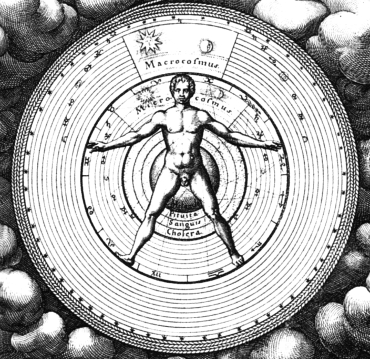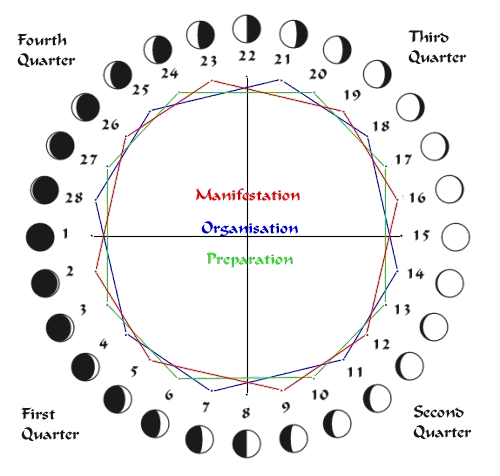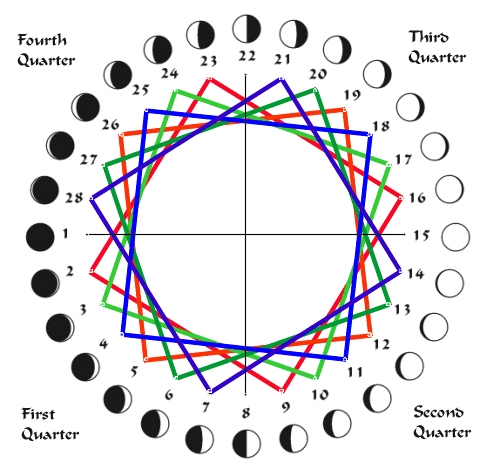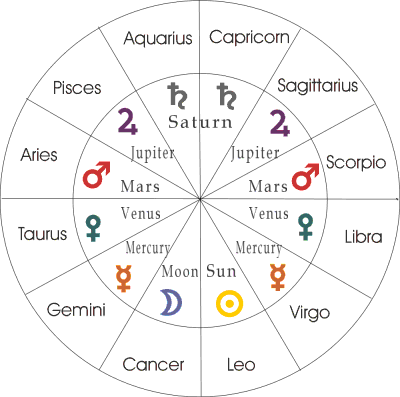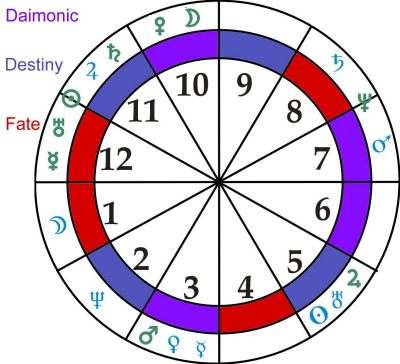Astrology
The Yeatses and AstrologyThe Yeatses were both practised, even expert astrologers. George was particularly adept at both drawing up and interpreting a horoscope, and Ann Saddlemyer�s biography, Becoming George, is not only full of references, but she even uses astrological terms for the section titles. Yeats�s maternal uncle, George Pollexfen, had been a keen astrologer too, and it is perhaps on account of his proximity to people who were more arithmetically competent than he was that Yeats tended to disparage his own skills, but they were considerable, as is seen from the many charts and horoscopes which he cast for himself. Despite the paraphernalia of Sun and Moon, however, the ascription of Phases to individuals in A Vision is not astrological, and, although the point is not laboured in the book itself, Yeats states in the first version that while the number of Phases in his system "is that of the Arabic Mansions of the Moon . . . they are used merely as a method of classification and for simplicity of classification their symbols are composed in an entirely arbitrary way" (AV A 12). All the same the terminology and symbolism of astrology permeates the work, and in some cases the exposition depends upon some grasp of the lore. G. R. S. Mead, reveiwing the first version thought that the �matter purports to be a scheme of lunar astrology� and the work certainly gives that impression. It is perhaps to be expected that the Yeatses would be unwilling entirely to jettison a body of knowledge which was so ingrained in both their minds, together with their training in the syncretic methodology of the Golden Dawn; and to a limited extent the astrological correspondences which pepper A Vision can be helpful to readers with a similar background. Certainly, if the reader does not know about astrology, some links are unclear: without knowing about astrological rulerships, for instance, it can be bewildering to see Yeats moving from Aries and Taurus to Mars and Venus (AV B 207) as if they are equivalents (which by astrological rulership they are), since he does not explain the link, and certain aspects of the groupings of the Phases are more readily understood with a knowledge of astrological categories. However, while they mystify and irritate readers unfamiliar with the symbols and jargon, they are probably misleading to those who see them as familiar landmarks for guidance. The true picture of the complexity of the correspondence only becomes clear in the Automatic Script, as the two systems shift in their relationship, entirely independent but able to be aligned according to the Ascendant and the precession of the equinoxes. Astrology appears to offer a more �objective� means of determining a person�s Phase than the subjective intuition, analysis or instruction which the Yeatses used, and the first attempt to make the Phases of the Moon work astrologically came in 1921, before he had even published the first version of A Vision. Frank Pearce Sturm was one of the �old fellow students� for whom Yeats claimed that he wrote A Vision, and he described Sturm to Olivia Shakespear in 1931 as an example of the �few very devoted readers� (L 781). In the first flush of excitement after hearing Yeats outline the System in conversation, Sturm writes: �I thought I was on the track of something I have been looking for all my life� (30 March 1921, LTWBY 2, 381). Having �worked over three hundred horoscopes in an attempt to substantiate what you told me�, he listed large numbers of people by the phase of the Moon at their birth, but he could find no pattern at all to the System. Indeed he showed a dogged determination and willingness �to master what is most abstract� partly out of interest and enjoyment of the subject, and partly because as a Buddhist, the System held out for him the possibility �to calculate how many incarnations any particular person has already endured�. Although Yeats told him in his reply that the �phases of the Moon in the symbolism I told you of have nothing to do with the horoscope, but with the incarnations only� (FPS 80), he pursued the subject further, writing only a fortnight after his first letter, that the Phase in fact indicated was the phase held by the Moon �at the time of the soul�s descent, the so-called pre-natal epoch of the astrologers� and he planned to write a book in which the System would be put into the mouth of Nicholas Flamel, whom he fancies �to be still alive in some Arabian or Coptic sect� (LTWBY 2, 383; as a point of interest, the pre-natal epoch does not work for Yeats�s own chart). Possibly Yeats felt that Sturm might trespass into the territory of Giraldus and Robartes, and he certainly felt that the System was still not clear enough in his own mind and was continuing to evolve, so that he was unwilling to let others adopt it as yet. Whatever the reason, Yeats�s condition that Sturm could not write about the System except with reference to what had already appeared in print at that date, as poetry and the notes attached to it, seems to have dampened Sturm�s enthusiasm. No doubt Yeats lacked the meticulous patience and painstaking tenacity of Sturm in analysing quantities of birth data, but he could very easily have followed Sturm�s lead or used his researches; however, Yeats also was very clear that it was unnecessary, misleading and inappropriate, since �You will get all mixed up if you think of my symbolism as astrological or even astronomical in any literal way� (FPS 88). Though there is no direct correlation between astrology and the System of the Moon�s Phases in A Vision, the Automatic Script actually shows that they did find a method of combining the two systems, although it was necessary to have the individual�s astrological and Phasic data assigned independently before the two could be married up together. This was excluded from the published versions, probably as being one level of complication too far, though glancing references hint at it. They also developed a method of superimposing one system on the other for the special case of the Universal Man, which forms the basis for the appearance of the Zodiac throughout the work. The HoroscopeOne of the features of the System which is seldom noted, and which Yeats alludes to in A Vision without ever making explicit, is that the Great Wheel of the Phases is only one of three factors in the make-up of the individual psyche, albeit the most important and the almost exclusive concern of A Vision. The Script makes it clear that there are �three circles - horoscope phases Equinox� (YVP 1 310). The circle of the horoscope is said to represent the �ego� or �persona�, that of the phases the bias of the soul or psyche, and the equinoctial circle, the general state of mankind or, at a more limited level, the race. Yeats incorporates a slightly different grouping of three circles into the original drafts for the Robartes-Aherne exposition: �The central circle is the horoscope of Gyraldus�, �the second circle . . . is symbolical of the personal spiritual life�, and the �third circle� shows �the twenty eight lunar phases� (YVP 4 18-19). Here the equinoctial circle is replaced by that of the personal Moments of Crisis, but the other two circles remain those of the Phases and the horoscope. As such, much of what makes up the personal identity derives not from the person�s Phase but from the more superficial level of the horoscope. Though they are independent systems, they can be combined: �According to this astrologic system the ascendant of a horoscope is always placed before it & judged directly under the middle point of the phase of the native, & all the aspects & planets are studied in relation to the phases at which they are placed� (YVP 4 79). George�s horoscope, with her Scorpio Ascendant aligned with her Phase 18, could then be examined with reference to the effect of, for example, her natal Jupiter�s being at Phase 1, enabling, along with her opposing natal Sun, �mediumship & clairvoyance� (YVP 1 272). Much was also made in the Script of the coincidence of George�s Scorpio Ascendant with her being in her Scorpio cycle of incarnations and the special effects that this produced (viz YVP 1 197; YVP 3 143-44). Like George, �Gyraldus, considered that he was in the 18th incarnation of his cycle� and �it is his horoscope that is in the center� of the frontispiece diagram: since Gyraldus was given Yeats�s face in Dulac�s woodcut, giving him George�s Phase was an elegant way of acknowledging the System�s dual debt, which disappeared with elimination of the horoscopic element from consideration.Importantly, however, the horoscope symbolises a whole layer of personal attributes and features separate from the disposition of the Phase, which may then work with or against the expression of that Phase, affecting whether a person lives according to or �out of phase�. In the manuscript draft of �The Discoveries�, Robartes explains the reason for the lack of similarity between two examples of Phase 17, Shelley and Landor: �The difference is in the horoscope not in the phase, Landor had some strong Martial, or Martial Jupiter influence whereas Shelley has a very powerful Venus and Mercury� (YVP 4 99; cf. TS YVP 4 37) and more detailed but impersonal comments on the planets� influence are given in another manuscript (YVP4 124). Similar differentiation is suggested in the published versions of A Vision through stray comments: Phase 20�s creative multiplicity gives to the man of action �the greatest possible richness of resource where he is not thwarted by his horoscope� (AV B 152-53); George Russell was diverted from the natural �abstract opinion� of Phase 25 towards the �ideal conventional images of sense� of his art, �because of the character of his horoscope� (AV B 176). This aspect is significant since it removes from the Faculties the role of informing the details of an individual�s traits and attributes, which are functions of the horoscope, chosen by the incarnating soul before its birth. It seems that the Faculties generally work at a deeper psychic level, so that they are not necessarily immediately evident within the outward expression of the quotidian self, and rather underlie the directions and trends of the individual life. The horoscope, in which there is a far greater range of variation, with almost infinite permutations of planetary detail, more readily expresses the �the bundle of accident and incoherence that sits down to breakfast�, whereas the Faculties are closer to the being �reborn as an idea, something intended, complete� (E&I 509; 1937). Astrology for A VisionThe Zodiac
The orbits of the planets around the Sun fall largely within a plane (Pluto is an exception), and from the Earth, this means that the paths of the other planets and the Sun seem to fall within a band of sky. The range within which the Moon�s path falls, though it is wider, is also largely in keeping with this band, and when it crosses the apparent path of the Sun this can cause eclipses, if the two bodies are suitably aligned with respect to Earth, so that the circle of the Sun�s path is called the ecliptic. The broader band, about 9� on either side of the ecliptic, is the Zodiac and the circle can be divided in numerous different ways. In practice only certain ones are used regularly, the 360 degrees of a circle (a division based on a rounded version of the Sun�s daily movement through the year), the 28 or 27 Mansions of the Moon (based on a rounded version of the Moon�s daily movement), and the 12 Signs of the Zodiac (based on a rounded version of the Sun�s movement between successive New Moons, and corresponding roughly with the segment of stars made invisible by the Sun). The stars which fall along the band of the paths of the Sun, Moon and planets have therefore acquired particular significance, and like the other stars of the sky were long ago formed into constellations, the general size of which is closest to the twelve-fold division. Since the majority of these constellations are identified with animals, they collectively give the Zodiac its name, from the Greek for animal and image. The astrological �Signs� of the Zodiac are regularised to 30� of the circle each, even though the constellations vary in size. 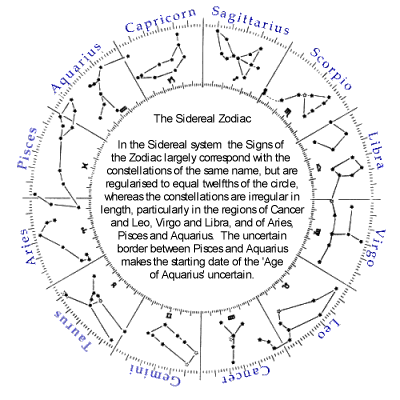
The starting point of the circle is marked in Western astrology by the Vernal Equinox, which is called the First Point of Aries, since the twelve divisions are named after the constellations with which they coincided around the time of Claudius Ptolemy (c.85-c.165). They no longer coincide because of the precession of the equinoxes, so that the Vernal Equinox now takes place when the Sun is aligned with the stars between Aquarius and Pisces, while the Summer Solstice, which marks the beginning of Cancer (hence Tropic of Cancer) now takes place when the Sun is between Taurus and Gemini; at the Autumnal Equinox, marking the beginning of Libra, the Sun is aligned with the stars between the constellations of Leo and Virgo, and at the Winter Solstice, marking the beginning of Capricorn (hence Tropic of Capricorn), it is between Scorpio and Sagittarius. The Signs of the Western, tropical Zodiac are, therefore, out of step with the constellations by a whole division but, in ascribing characteristics to the different Signs, certain elements and traits are still often seen in terms of the original constellations, so that the Sign of Aries is seen as enterprising and combative, like the ram or bell-wether, and Libra, often described as seeing both sides of an issue and indecisive, can owe something to the imagery of the balance or scales. This can be ascribed to mnemonic convenience as easily as to ignorance of the shift, since the majority of other characteristics have no obvious relevance to the Signs� pictorial symbolism, but can make the situation slightly confusing. One of the characteristics of the Zodiac which underlies certain aspects of A Vision and its treatment of the Phases, is the ways in which the Signs are grouped. Part of this derives from the symbolism and mathematical properties of the number 12, which as the product of three and four or of two and six, lends itself to easy divisions. The twelve months of the year derive from an approximation of the number of lunations in a year (12.4), but 12 has a symbolism of completeness and encompassing variety, so that the 12 tribes of Israel and the 12 disciples of Jesus are seen as potentially embodying the whole of their society. The Zodiac itself precedes such attributions and it is partly because of the astrological Zodiac�s encompassing of the types of humanity that 12 is seen as sufficient to represent the whole. Each Sign of the Zodiac can be seen as the unique combination of two groups of attributes, the four ancient elements, Earth, Water, Air, Fire (which can be seen as equivalents of states of matter: solid, liquid, gas, plasma) and three basic qualities, movement, fixity and change (Cardinal, Fixed and Mutable). Three equidistant Signs are ascribed to each of the four elements, so that they are often referred to as the Triplicities or Trigons, while four equidistant Signs are ascribed to each of the three Qualities, so that these are often referred to as the Quadruplicities.
The Signs which partake of an Element or Quality are thought to share a mode of action or quality: Fire, to be ardent and enthusiastic; Earth, to be practical and cautious; Air, to be intellectual and communicative; Water, to be emotional and sensitive; Cardinal, to be outgoing and controlling; Fixed, to be stable and resistant to change; and Mutable, to be adaptable and unstable. Therefore Aries as Cardinal Fire, is considered to combine ardency with an outgoing nature, while Leo combines the same ardency with resistance to change, and so on. When taken in order, the Signs can be viewed as forming three tetrads, following the sequence Fire, Earth, Air, Water, or four triads, following the sequence Cardinal, Fixed, Mutable. The attributions of the two influences create separate sets of groupings, to which can also be added the divisions by two and six: the Signs from Aries to Virgo are seen as more focussed on the self, while those from Libra to Pisces repeat the same themes in a more socially oriented way; grouping two sets of Elements together, alternate Signs are labelled masculine/positive (Fire and Air) and feminine/negative (Earth and Water) — this latter set of terms nowadays seems clumsy, especially since the Bull seems singularly unfeminine. In terms of similarities:
The Planetary RulershipsThe Zodiac division is fundamentally a solar division, related to the Sun�s monthly movement, and Yeats uses it in A Vision when he is referring to Solar elements within the System. Since the Faculties are fundamentally Lunar in nature, these are usually described in terms of the Lunar Phases, and since the Principles are fundamentally Solar in nature, these are usually described in terms of the Zodiac. However, within the Principles, there is a further division of Solar and Lunar, so that the Lunar Principles, Husk and Passionate Body, may also be described in terms of the Moon�s Phases, and movement of Creative Mind, the active Solar Faculty, is sometimes described in terms of the Zodiac rather than the Phases of the Moon. This is relevant in one of the more obscure passages of A Vision, Sections XI and XII of Book 2 (AV B 207-208), which has a bearing on the poems �The Double Vision of Michael Robartes� (VP 382) and �Conjunctions� (VP 562), the latter also linked to the horoscopes of his children. Each of the Signs is associated with or �ruled� by a particular planet. In the ancient system, the two lights, the Sun and Moon, each ruled one Sign, while the other planets each ruled two, arranged in the order of speed of movement. The Sun rules Leo and the Moon Cancer, while Mercury rules the Signs on either side of these two, Gemini and Virgo; Venus rules the next pair, Taurus and Libra; Mars, Aries and Scorpio; Jupiter, Pisces and Sagittarius; Saturn, Aquarius and Capricorn. The Yeatses preferred these traditional rulerships and used them in their calculations and comments, but modern astrologers have attributed rulerships to the planets discovered by the telescope. In these rulerships Uranus shares the rulership of Aquarius with Saturn, Neptune shares Pisces with Jupiter, and Pluto shares Scorpio with Mars.
Colin McDowell has examined Yeats�s use of these rulerships in some detail in �"Heraldic Supporters": Minor Symbolism and the Integrity of A Vision�, YA 10 (1993). My reading differs slightly from his, but the essentials remain the same, and the implications are examined in the context of the Historical Cycle. Very briefly, since Yeats places Phase 15 at the First Point of Aries, with the Signs of the Zodiac proceding clockwise from Phase 15, the Phases leading up to Phase 15 (12, 13, 14) coincide with Solar Aries and Taurus, while those immediately after (16, 17, 18) coincide with Pisces and Aquarius. Since the Creative Mind mirrors Will in its movements, this means that as Will passes through the Phases towards Phase 15 (12 —> 13 —> 14), Creative Mind passes through the Sign of Aquarius into Pisces (Yeats�s account is muddied here, since he makes it Pisces to Aquarius); when the Will is passing through the Phases after the Full Moon ( 16 —> 17 —> 18), the Creative Mind is passing through Aries into Taurus. Since a dispensation starts somewhat after Phase 15 for a primary dispensation, it starts under the joint influence of Aries and Taurus, or Mars and Venus, while an antithetical dispensation, which begins to influence before it starts, exhibits the influence of Jupiter and Saturn. The Mundane HousesThe Mundane Houses of the horoscope follow a pattern similar to that of the Qualities/Quadriplicities, but their division into quarters is more marked. If the Zodiac represents the apparent movement of the heavens, the Mundane Houses are, as the name indicates, linked with Earth. Given the relativity imposed by taking the viewer�s standpoint as the reference, the frame of the horizon is seen as fixed, while the heavens move over the horizon, culminate and then set. The Houses are constructed around the horizon and the culminating point (the meridian or Midheaven), and it is as if a fixed template is placed over a rotating disc of the Zodiac, as in an astronomer�s planisphere. The eastern horizon of any place upon the Earth remains the rising point or Ascendant day or night, though its significance in the horoscope derives from the point of the heavens rising at the moment. At any moment, the Midheaven is the same for all points on a given line of longitude, but the Ascendant varies with latitude, so that these two reference points effectively define the birth-place. The circle from the Ascendant is divided into twelve sectors, in a pattern that probably derives from the Zodiac itself, since the sequence follows the same anti-clockwise direction, counting first the unseen skies �under the surface� of the Earth, so that the end of the Sixth House and beginning of the Seventh is on the Western horizon. The culminating point or Midheaven (in the South, in the Northern hemisphere) is taken as marking the start of the Tenth House, so that the sectors between South and East are in order the Tenth, Eleventh and Twelfth Houses. The First House lies �under� the horizon, the Second and Third follow, to the start of the Fourth House, which is at the nadir, or point opposing the Midheaven (the Latin terms Imum coeli and Medium coeli or the abbreviations IC and MC are often used). The Houses concern areas of life where the energies represented by the planets are expressed, as opposed to the Signs of the Zodiac which are thought to show how the planets are expressed. Those which start with the key points or angles of the horoscope, the Ascendant, Midheaven, and their opposites, are termed �Angular� and are thought to signify the key areas of life: the self (First), the home and family (Fourth), the partner (Seventh) and the career (Tenth). Planets placed in these Houses, comparable to the Cardinal Signs, are considered to be stronger, concerned with initiating matters. The following four are called �Succedent� and are tied to resources, habits and personal enjoyment: possessions (Second), creativity and love affairs (Fifth), inheritance, sex and death (Eighth), friendships (Eleventh). Planets placed in these Houses, comparable to the Fixed Signs, are considered to work stably. The final four are called �Cadent� and are linked to human relationships, the life of the mind and transitions: local movement (Third), health (Sixth), wider exploration (Ninth), hidden aspects of life (Twelfth). Planets placed in these Houses, comparable to the Mutable Signs, are considered to work unstably, and possibly to be weakened. There is also a polarity between the Houses, so that pairs of opposites are even more clearly linked, as is also the case with the Signs of the Zodiac. If the First House deals with the self, the Seventh House deals with the partner, sweetheart or even enemy. The Second House deals with possessions and money, the Eighth House with others� possessions and money, inheritance; the Third House with local communication and education, the Ninth House with travel and higher education; the Fourth House deals with the home and the Tenth House with the career, and both deal with parents; the Fifth House deals with creativity and love affairs, while the Eleventh deals with ideas, associations and friendships; the Sixth House deals with health, work and the day-to-day, the Twelfth with illness, isolation and the unconscious.
The four quarters of the horoscope have certain emphases which the Houses share, though the agglomeration of individual attributions can sometimes obscure this and seem rather random. The emphasis of the first quarter (1, 2, 3) is on the self, of the second quarter (4, 5, 6) on the quotidian environment, of the third quarter (7, 8, 9) on relationships with others, and of the fourth quarter (10, 11, 12) on wider social ties. The first of the group, the Angular House, shows the clearest manifestation of the quarter�s emphasis, the second, the Succedent House, ways in which it is sustained or diversified, and the third, the Cadent House, a transition towards the concerns of the following quarter. Indeed, some writers on the subject take the Cadent Houses as the prelude to the Angular House and so group the Houses around the angles, Cadent, Angular, Succedent, (12, 1, 2; 3, 4, 5; 6, 7, 8; 9, 10, 11), rather than by the quarters. Yeats�s Quarters show some similarities of emphasis with those of the Mundane groupings, with Phase 1 (North) taking the place of the Ascendant (East), though the links are clearer in the primary half of the Wheel than in the antithetical. Similarly the Triads of Phases, Manifestation-Arrangement-Preparation, show a similar pattern to the sequence Angular-Succedent-Cadent. These patterns have a certain internal logic, the progression from a centre outwards, from the central self towards the other, which is more important than any direct influence, and the Yeatses� familiarity with these categories certainly affected the way that they approached their own System, even if they did not directly inform its structure. The Houses and FateThe classical names for the Houses are given above, since the distinctions created possibly also influence Yeats�s thinking, particularly with respect to the difference between forms of Fate, especially Destiny and Necessity, Choice and Chance (see Destiny, Fate and Fatalism). This dual aspect of Fate is linked with the distinction in Hellenistic astrology between the Fate of the Fifth and Sixth Houses, which is circumstantial, accidental and unpurposed: Chance, Fortune, Tyche, Fortuna; opposed to this is the Fate of the Eleventh and Twelfth Houses, which derives from the inspiration of the daim�n or genius and is part of the individual�s purpose, Destiny or Choice, though this may remain beyond the conscious mind. The term Fate has a variety of meanings, though, and all of the Houses can be seen as linked to different manifestations or aspects of Fate, in the sense of what has been alloted to an individual, at least in terms of classical or Hellenistic thought. Though Jesus�s parable of the talents also deals with the question of unequal lots in life, the element of Fate in astrology is one of the reasons that the Christian church was opposed to it, since it appears to go against Divine Providence and, in its prognostications, to diminish free will (see Tester, A History of Western Astrology). The Yeatses similarly seem to have viewed the Houses in terms of varieties of fate in the Automatic Script, though with rather different distinctions, both in terms of the Houses and in terms of kinds of Fate. They were examining the astrological indications of the Daimon, and the way in which the horoscopes of George and W. B. Yeats interacted (see the Yeatses� Charts), and the Instructors commented that George�s �horoscope is mainly Fate� whereas Yeats�s �is destiny�, and went on to specify three sets of Houses: those of Fate, those of Destiny and those of the Daimon. Here Fate seems to be used in the sense of Necessity or Fortune and opposed to Destiny, which is also separated from the Daimon. These follow neither classical attributions nor the patterns of angularity, and, despite some similarity to the patterns of rulerships, the rationale is not clear:
Yeats summarised the information again more neatly (YVP 2 563) and in the Card Index (P30; YVP 3 358), though filed under �Phases� for some reason and apparently querying the attributions of Houses 7, 11 and 12. Yeats�s Saturn was placed in the same Zodiacal position as George�s Sun (23� Libra), an aspect that did not necessarily bode terribly well for the couple, but the Script shows how they discovered positive inidications in the configuration. Saturn is one of two planets placed in a House of Fate for W. B. Yeats as well, and seen as curbing the influence of George�s rather stronger predominance of fated positions, particularly the influence of the �modern� planets, Uranus and Neptune. Further, the link of emotion to Fate here in the Script may contribute to Yeats�s aphoristic abstract of the System in the light of astrology called the �Seven Propositions� (1929). The allocation of the Houses to kinds of Fate, along with most of the directly astrological material, does not appear in A Vision and does not seem to have been pursued any further in the Script or the associated work, but it does throw an interesting side-light on the way in which the Yeatses� astrological knowledge informed their thinking in other areas. If occult thought tends to proceed by analogy and to fit experience arbitrarily into pre-defined categories, as argued by Brian Vickers (�On the Function of Analogy in the Occult�), it also has some of the qualities alluded to by Hermann Hesse in The Glass Bead Game (Das Glasperlenspiel, 1943) of moving effortlessly across normal boundaries through symbolic connections. By using the symbolic connections of astrology, the Yeatses are able to explore, for instance, concepts of fate in unexpected ways. Many such forays lead to dead ends or peter out with little result, however even such fruitless explorations can come to inform poetic thought as well, both directly and indirectly, since such thought often moves similarly through analogy and symbol. For an exploration of how the Yeatses used astrology in the Automatic Script, see the essay "Shifting Sands: Dancing the Horoscope in the Vision Papers," by Colin McDowell in the collection W. B. Yeats's "A Vision": Explications and Contexts, edited by Neil Mann, Matthew Gibson, and Claire Nally (Clemson University, 2012). Seven PropositionsEsotericism and OccultismDestiny, Fate and FatalismThe Yeats�s Birth-Charts: InterpretationsThe Mansions of the MoonThe Lunation Cycle in AstrologyPrecession and the Astrological Great YearAstronomyAbbreviationsBibliography | ||||||||||||||||||||||||||||||||||||||||||||||||||||||||||||||||||||||||||||||||||||||||||||||||||||||||||||||||||||||||||||||||||||||||||||||||||||||||||||||||||||||||||||||||||||||||||||||||||
